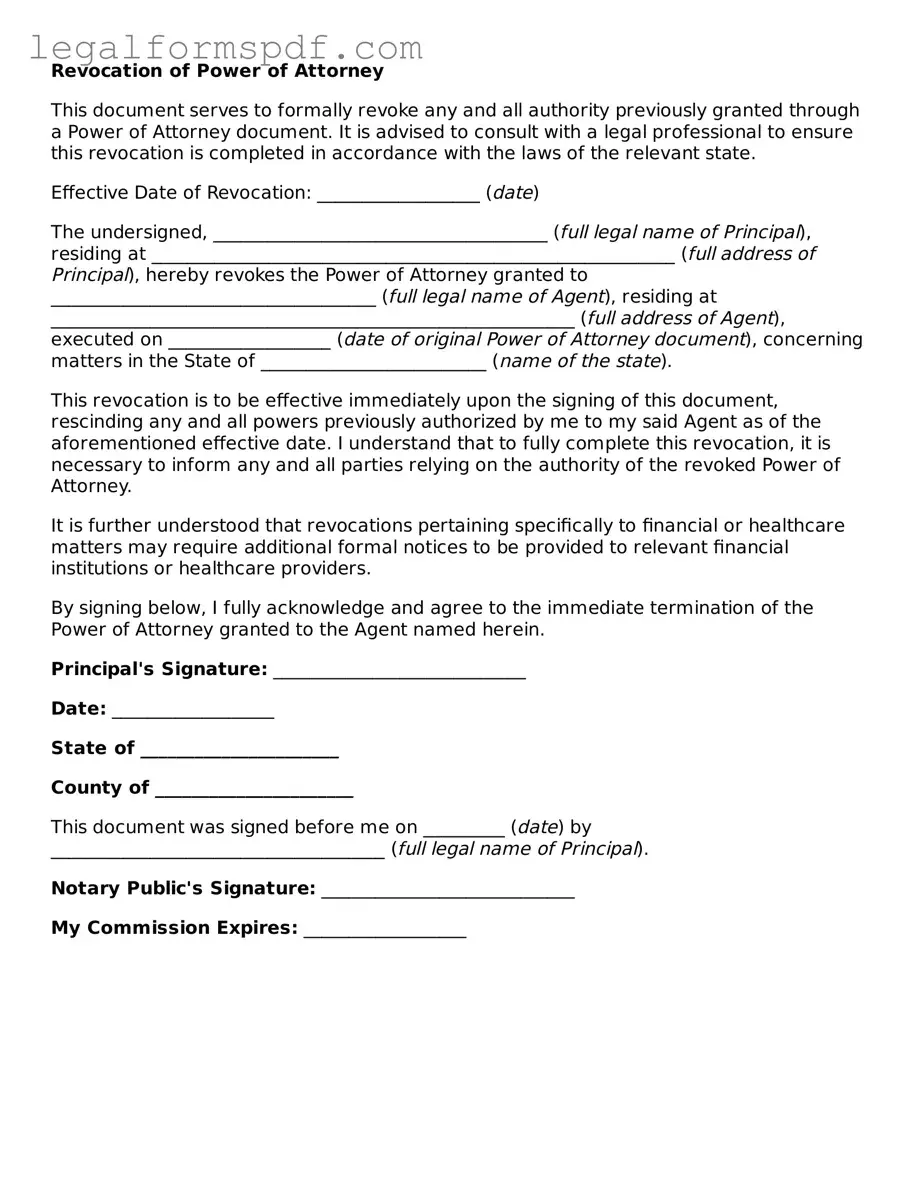What is a Revocation of Power of Attorney Form?
A Revocation of Power of Attorney Form is a legal document used to cancel or revoke a previously granted Power of Attorney (POA). This means that the person who had been given the authority to act on someone else's behalf, known as the agent or attorney-in-fact, will no longer have that authority once the revocation is effective.
When should one use a Revocation of Power of Attorney Form?
One should use a Revocation of Power of Attorney Form when they wish to terminate the powers granted in an existing Power of Attorney document. This could be due to a change in circumstances, such as a breakdown in trust, a change in the principal's requirements, or because the tasks outlined in the POA have been completed.
How does one revoke a Power of Attorney?
Revoking a Power of Attorney involves creating and signing a Revocation form. This form must clearly state the intent to revoke the powers granted. It is also highly recommended, though not always required, that it be notarized. After completion, the Revocation should be distributed to any parties who were relying on the original POA, including the agent and relevant financial or healthcare institutions.
Is a witness or notarization required for the Revocation to be effective?
Requirements vary by state. Some states require the Revocation to be witnessed, notarized, or both to be legally effective. It’s important to consult local laws to ensure that the revocation complies with state requirements. Even in states where notarization is not mandatory, notarizing the document can add an extra layer of legitimacy and help prevent disputes.
What happens if the Revocation of Power of Attorney is not acknowledged by the agent?
If the agent does not acknowledge the revocation, the principal should distribute copies of the Revocation form to any institutions or third parties that might rely on the original Power of Attorney. By doing so, these parties are officially informed of the revocation and the agent's authority is practically nullified, preventing them from legally acting on behalf of the principal.
Do I need a lawyer to revoke a Power of Attorney?
While it is not strictly necessary to have a lawyer to revoke a Power of Attorney, consulting one can be beneficial. A lawyer can provide advice on how to properly execute the revocation to ensure it meets legal requirements and is effective, and they can also assist in communicating the revocation to the necessary parties.
Can I revoke a Power of Attorney if I am incapacitated?
No, a fundamental requirement for revoking a Power of Attorney is that the principal (the person who granted the power) must be mentally competent. This means they understand the nature and implications of their action. If a principal becomes incapacitated, they cannot revoke a POA, and it may be necessary for a court to get involved to remove the agent’s authority.
Will revoking a Power of Attorney affect my ability to grant a new one in the future?
No, revoking a Power of Attorney does not affect your ability to grant a new one in the future. Individuals have the right to appoint or revoke powers of attorney as their circumstances and needs change, provided they are competent at the time of making those decisions.
How can I ensure that my Revocation of Power of Attorney Form is legally valid?
To ensure your Revocation of Power of Attorney Form is legally valid, make sure the document clearly states your name, the name of the agent, and your intention to revoke the powers granted. It should be signed and dated by you. Complying with state-specific requirements, such as notarization and witness signatures, is also crucial. Distributing copies to relevant parties further establishes the revocation’s validity.
